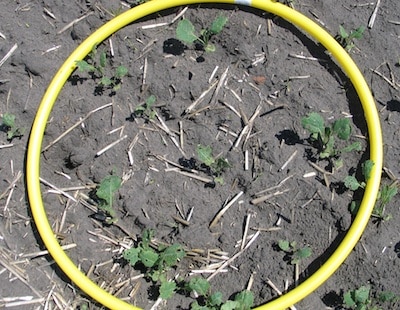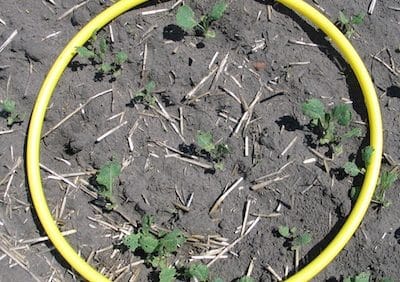
For the variety you have chosen to reach its full potential, it is important to get an adequate number of healthy plants growing. Agriculture and Agri-Food Canada surveys of canola fields in Alberta in 2010 and Saskatchewan fields in 2012 found that only about half of fields achieved an average of 5 plants or more per square foot. Canola plant stands with fewer than 5 plants per square foot will almost always have yield loss compared to the same variety at 5 or more plants per square foot.
In the AAFC survey, 71% of Alberta growers reported using a seeding rate of 5 lb./ac. Of them, 40% ended up with stands of less than 4 plants per square foot. All fields seeded at rates greater than 5 lb./ac. had crop stands within the recommended range or greater.
If growers want to hit the 5 plants per square foot threshold, they may have to increase their seeding rates accordingly, or take steps to improve seedling survival so more seeds grow into productive plants.
The following steps can improve seedling survival:
1. Seed shallow. Half an inch to one inch depth below the packer furrow is the recommended seed depth for canola. This will reduce days to emergence and reduce the seed energy required for emergence, producing more vigorous seedlings.
2. Seed slower. At higher speeds, rear openers tend to throw more soil over the front rows. Seed in these front rows will be buried deeper, making them slower to emerge — if they emerge at all.
3. Limit seed-placed fertilizer. Nitrogen fertilizer placed in the seed row can increase seedling loss to due toxicity and salt effect. The best practice is to place phosphate fertilizer with the seed at rates up to 30-40 pounds of phosphate per acre, and then put the rest of the N and other nutrients away from the seed row.
4. Seeding into warmer soils will increase survival but this needs to be balanced against the benefits of early seeding. Canola can germinate in cooler soils, but emergence can be highly uneven and seedling mortality will increase.
5. Anything that slows canola emergence — cool soils, for example — extends the time when seed is vulnerable to seedling diseases and flea beetles. Seed treatments may not last long enough with slow emergence to provide full level control.

